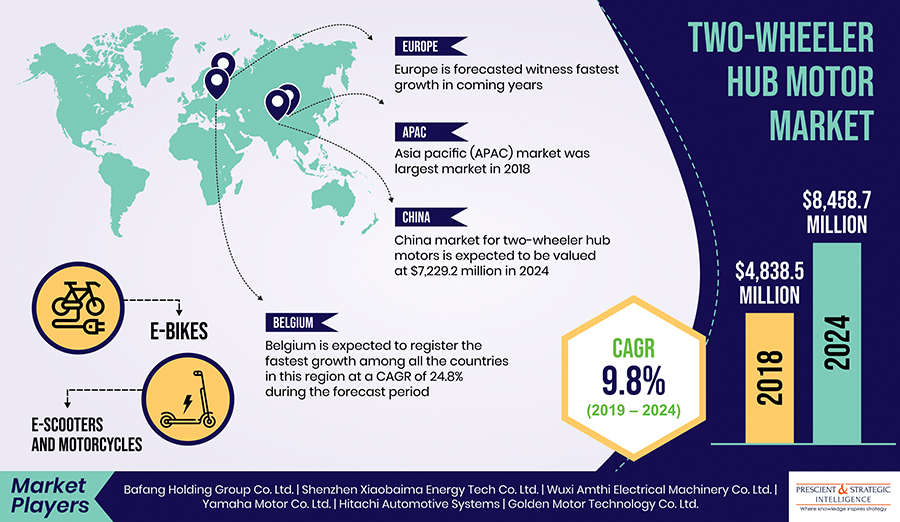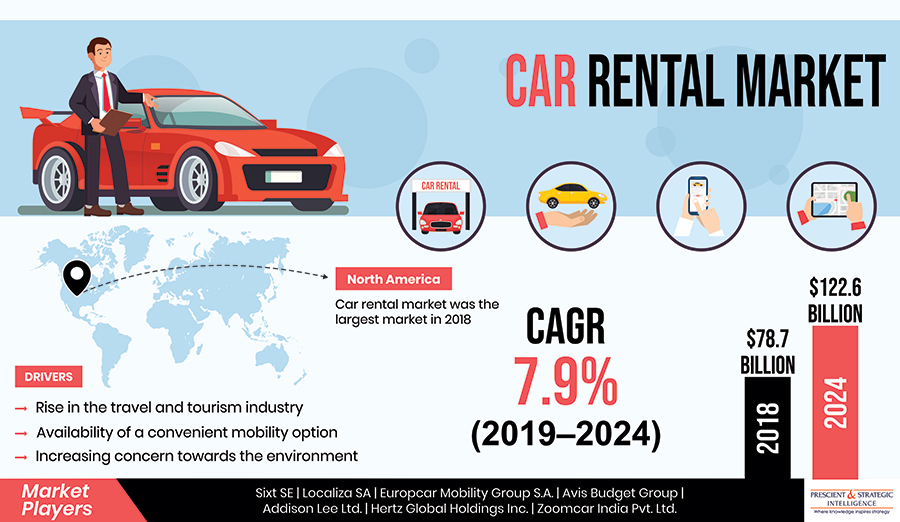In 2018, the global two-wheeler hub motor market was valued at $4,838.5 million, and it is expected to reach $8,458.7 million by 2024, witnessing a CAGR of 9.8% during 2019–2024. In terms of end use, the demand for the product was the higher in 2018 among OEMs.
However, the faster growth in the two-wheeler hub motor market is expected to be witnessed by the aftermarket category. The rising adoption of electric two-wheelers would propel the demand for their components. The lesser lifespan of hub motors compared to that of electric two-wheelers would lead to a greater demand for them in the aftermarket, in the forecast period.
What are the factors impacting the growth of this market?
The growing demand for high-powered motors is a key trend being observed in the two-wheeler hub motor market. Major manufacturers, such as Zero Motorcycles Inc., BMW AG, and Vectrix, are offering electric motorcycles with a motor power more than 30 kW and have announced their plans of launching models of even higher motor power. For instance, in November 2018, Savic Motorcycles, Australia’s first electric motorcycle company, announced that a new electric model, Cafe Racer, with 60 kW motor power, will be launched by 2020. Besides, many OEMs of conventional gasoline-based motorcycles have announced their plans of introducing high-powered electric models in the near future. Thus, the increasing demand for higher-powered motors is one of the major trends being observed in the market.

To receive a free sample copy of this report
The growing adoption of electric two-wheelers is a major growth driver for the two-wheeler hub motor market. The accelerating rate of environmental degradation by greenhouse gas emissions has become a major concern for governments across the world. The increasing amount of exhaust fumes from automobiles, including two-wheelers, is contributing significantly to the degradation of air quality. Thus, the governments of different countries are taking various initiatives to curb the growing pollution levels. For instance, in many countries, the government has incentivized the purchase of electric motorcycles and scooters to promote the adoption of environment-friendly transport. Thus, such initiatives by the governments to increase the adoption of electric vehicles as an effort to reduce carbon emissions are driving the growth of their components’ markets.
Geographical Analysis of Two-Wheeler Hub Motor Market
The APAC region alone held over 95.0% volume share in the two-wheeler hub motor market in 2018. The dominance of the APAC region is mainly attributed to the massive demand for electric two-wheelers in China. Moreover, the Chinese government is actively making efforts to reduce vehicular pollution by implementing restrictions on gasoline-driven vehicles, which majorly contributes to the rapid adoption of electric alternatives. Additionally, Chinese consumers have been receiving cash incentives in the form of subsidies, which is further encouraging them to shift to these vehicles.
Apart from the APAC region, the North American and European regions show promising growth prospects for the two-wheeler hub motor market. The introduction of stringent government norms as well as high environmental concerns have the potential to spur the market growth in these regions.
Competitive Landscape of Two-Wheeler Hub Motor Market
The global two-wheeler hub motor market is highly fragmented in nature. The top five players in the market together accounted for less than 40.0% of the market revenue in 2018. Yadea Technology Group Co. Ltd. was the market leader, followed by Robert Bosch GmbH, Ananda Drive Techniques Co. Ltd., Jiangsu Xinri E-Vehicle Co. Ltd., and Zhejiang Luyuan Electric Vehicle Co. Ltd.
However, the faster growth in the two-wheeler hub motor market is expected to be witnessed by the aftermarket category. The rising adoption of electric two-wheelers would propel the demand for their components. The lesser lifespan of hub motors compared to that of electric two-wheelers would lead to a greater demand for them in the aftermarket, in the forecast period.
What are the factors impacting the growth of this market?
- Rapid Adoption of Electric Two-Wheelers is Driving the Growth of the Market
The growing demand for high-powered motors is a key trend being observed in the two-wheeler hub motor market. Major manufacturers, such as Zero Motorcycles Inc., BMW AG, and Vectrix, are offering electric motorcycles with a motor power more than 30 kW and have announced their plans of launching models of even higher motor power. For instance, in November 2018, Savic Motorcycles, Australia’s first electric motorcycle company, announced that a new electric model, Cafe Racer, with 60 kW motor power, will be launched by 2020. Besides, many OEMs of conventional gasoline-based motorcycles have announced their plans of introducing high-powered electric models in the near future. Thus, the increasing demand for higher-powered motors is one of the major trends being observed in the market.

To receive a free sample copy of this report
The growing adoption of electric two-wheelers is a major growth driver for the two-wheeler hub motor market. The accelerating rate of environmental degradation by greenhouse gas emissions has become a major concern for governments across the world. The increasing amount of exhaust fumes from automobiles, including two-wheelers, is contributing significantly to the degradation of air quality. Thus, the governments of different countries are taking various initiatives to curb the growing pollution levels. For instance, in many countries, the government has incentivized the purchase of electric motorcycles and scooters to promote the adoption of environment-friendly transport. Thus, such initiatives by the governments to increase the adoption of electric vehicles as an effort to reduce carbon emissions are driving the growth of their components’ markets.
Geographical Analysis of Two-Wheeler Hub Motor Market
The APAC region alone held over 95.0% volume share in the two-wheeler hub motor market in 2018. The dominance of the APAC region is mainly attributed to the massive demand for electric two-wheelers in China. Moreover, the Chinese government is actively making efforts to reduce vehicular pollution by implementing restrictions on gasoline-driven vehicles, which majorly contributes to the rapid adoption of electric alternatives. Additionally, Chinese consumers have been receiving cash incentives in the form of subsidies, which is further encouraging them to shift to these vehicles.
Apart from the APAC region, the North American and European regions show promising growth prospects for the two-wheeler hub motor market. The introduction of stringent government norms as well as high environmental concerns have the potential to spur the market growth in these regions.
Competitive Landscape of Two-Wheeler Hub Motor Market
The global two-wheeler hub motor market is highly fragmented in nature. The top five players in the market together accounted for less than 40.0% of the market revenue in 2018. Yadea Technology Group Co. Ltd. was the market leader, followed by Robert Bosch GmbH, Ananda Drive Techniques Co. Ltd., Jiangsu Xinri E-Vehicle Co. Ltd., and Zhejiang Luyuan Electric Vehicle Co. Ltd.













